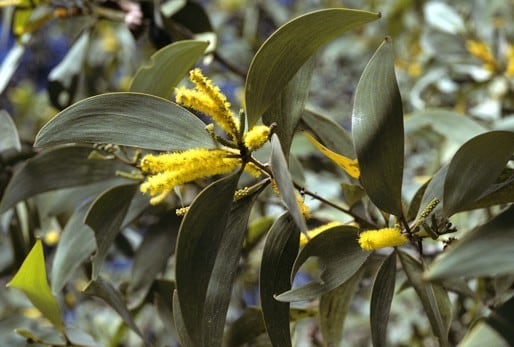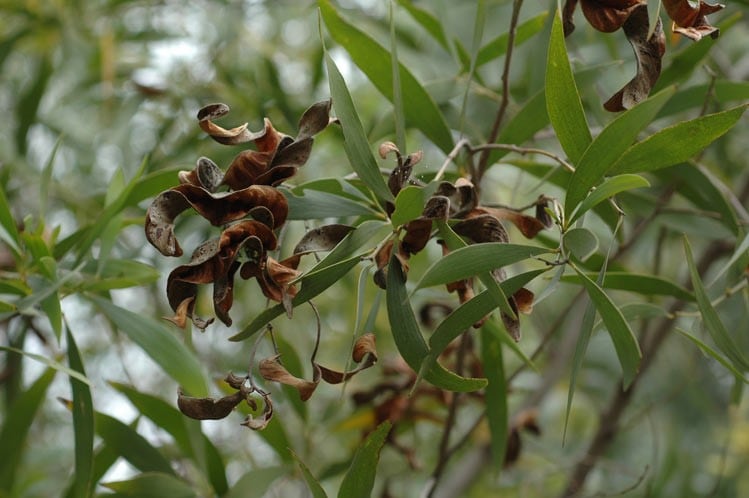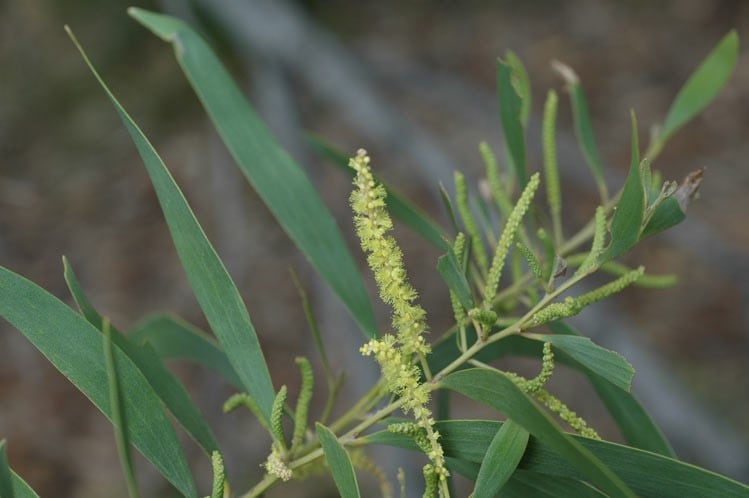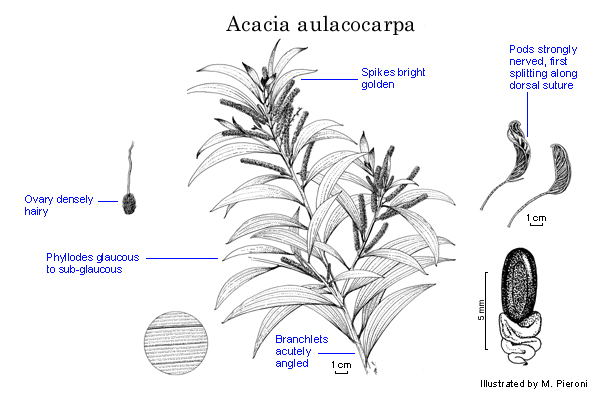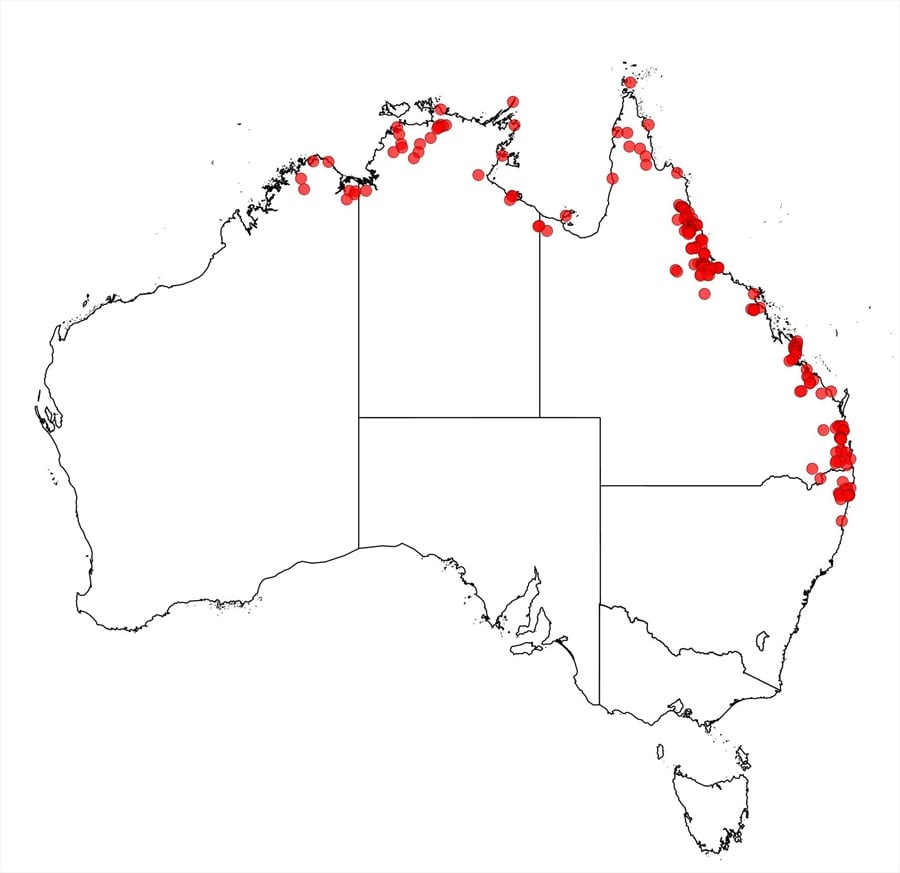Acacia aulacocarpa A.Cunn. ex Benth.
WATTLE
Acacias of Australia
Common Name
Golden-flowered Salwood, Salwood, Lancewood
Family
Fabaceae
Distribution
Discontinuous primarily in coastal areas and adjoining tablelands of the Great Dividing Ra. in eastern Qld from near Daintree to just S of Brisbane, and near Grafton, N.S.W; occurs on a number of islands off Qld.
Description
Shrub or tree 2–8 (–15) m high, canopy blue-green. Bark smooth except shallowly rimose on largest trees. Branchlets acutely angled for 10-25 cm (occasionally more) below apex, orange or green, glabrous. Phyllodes dimidiate (sometimes recurved at apex) to subfalcate, (3–) 5–12.5 cm long, 7–35 mm wide, thinly coriaceous, glaucous to subglaucous, glabrous; longitudinal nerves numerous (3–4 (–5) per mm), parallel and not anastomosing, with 3 main nerves slightly raised (when dry), broader and more prominent than the rest, 3 or 4 less prominent secondary nerves also present, the minor nerves not raised, main nerves commonly confluent with lower margin for a short distance above pulvinus; pulvinus 4–8 (–10) mm long. Inflorescences simple, 1–2 (–4) per axil; peduncles (3–) 4–8 (–10) mm long; spikes 2–5 (–6) cm long, bright golden. Flowers 5‑merous; calyx gamosepalous, c. 0.5 mm long, shallowly dissected, ±glabrous; ovary glabrous. Pods narrowly oblong, sometimes twisted, straight to shallowly curved, 1.5–8 cm long, usually 0.8–1.5 cm wide, woody, resinous, glabrous, reddish brown, dehiscing along dorsal suture, strongly obliquely to ±longitudinally reticulately nerved. Seeds oblique, ovate to oblong or elliptic, 3.5–5 mm long, brown to black; aril greyish cream.
Phenology
Flowers Jan.–June.
Habitat
Grows in clay or loam along watercourses or on rocky outcrops in open forest.
Specimens
Qld: Ngunngun, Carrington Falls, 8 km SSE of Atherton, J.R.Clarkson 9712 (BRI, DNA, K, L, MBA, NSW, PERTH); c. 2 km W of Glass House Mountains township, M.W.McDonald & B.R.Maslin BRM 7612 (BRI, CANB, DNA, K, NSW, NY, PERTH); base of Mt. Flinders (on NNW side), c. 60 km due N of Yeppoon, M.W.McDonald & B.R.Maslin BRM 7615 (BRI, PERTH). N.S.W.: Fortis Creek State Forest, P.Richards 658 & R.Armstrong (CANB, NE, NSW).
Notes
A very variable species, see M.W.McDonald & B.R.Maslin, op cit. 33, for discussion.The illustration of A. aulacocarpa in F.Mueller, Iconogr. Austral. Acacia dec. 9 [pl. 9] (1888) is not of that species; it consists of elements of A. crassicarpa and probably A. lamprocarpa, see M.W.McDonald & B.R.Maslin, op cit. 22, for discussion.
Most closely related to A. celsa and A. disparrima but distinguished from these species, and all other members of the group, by a combination of its bright golden spikes, subglaucous to glaucous phyllodes, densely hairy ovaries and strongly obliquely to ±longitudinally nerved pods. Putatively hybridizes with A. crassicarpa near Townsville.
The treatment of A. aulacocarpa by NSW, Fl. Australia 11B: 168 (2001) is modified here in accordance with the revision of the species by M.W.McDonald & B.R.Maslin, Austral. Syst. Bot. 13: 29–34 (2000).
Acacia aulacocarpa along with A. celsa, A. crassicarpa, A. disparrima subsp. disparrima and subsp. calidestris, A. lamprocarpa, A. midgleyi, A. peregrina (New Guinea) and A. wetarensis (Indonesia) comprise the ‘A. aulacocarpa group’, fide M.W.McDonald & B.R.Maslin, op cit. 21–78.
FOA Reference
Data derived from Flora of Australia Volumes 11A (2001), 11B (2001) and 12 (1998), products of ABRS, ©Commonwealth of Australia
Author
Revised by B.R.Maslin
Dr M.D.Tindale and Dr P.G.Kodela with the assistance of M.Bedward, S.J.Davies, C.Herscovitch, D.A.Keith and/or D.A.Morrison
This identification key and fact sheets are available as a mobile application:
URL: https://apps.lucidcentral.org/wattle/
© Copyright 2018. All rights reserved.
